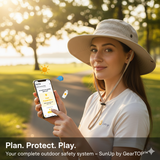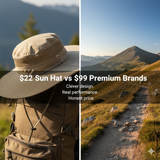
Vitamin D is a vitamin that you can get from exposure to the sun. The sun plays an important role in the production of vitamin D.
The best way to get enough of the vitamin is through unprotected sun exposure. But, this can result in a whole new set of serious issues. Moreover, many people believe that using sunscreen and other forms of sun protection causes vitamin D deficiency.
In this article, we’ll discuss the importance of vitamin D. We'll also talk about the benefits it gives to your body. We will also cover how to stay protected from too much sun exposure while getting your healthy dose of vitamin D.
Table of Contents:
- What are the benefits of Vitamin D?
- What is the healthy level of vitamin D?
- What is the connection between vitamin D and the sun?
- What is the best time to get vitamin D from the sun?
- How long do you have to be in the sun to get vitamin D?
- Does sunscreen affect vitamin D levels?
- How do you protect yourself from sun damage while getting Vitamin D?
- Buy GearTOP Sun Hats for Sun Protection
- Conclusion
What are the benefits of vitamin D?

We all need vitamin D. It promotes bone growth, and without it, we'd be at risk of conditions like osteoporosis. Vitamin D also boosts the immune system. Some doctors believe it can help prevent diseases like the risk of skin cancer, aging, and skin damage.
Here are some of Vitamin D’s benefits to the body:
- Promotes healthy bones
- Supports good immune function
- Reduces the risk of multiple sclerosis
- Decreases the chance of developing heart diseases
- Might support weight loss
- Lowers the risk of diabetes
- Protection from certain cancer types
What is the healthy level of vitamin D?
So, what is a healthy vitamin D level?
Ask your primary care provider to test your vitamin D level when you go in for your annual checkup. Here's an explanation of what the lab numbers mean:
Below 30 indicates vitamin d deficiency. You should discuss vitamin D supplementation with your doctor to make sure you're using the right dosage.
- 30-50:Inadequate for bone health and overall health
- 50-70:Optimal (more is not necessarily better)
- 100 and above: Excessive (could have adverse health effects)
What is the connection between vitamin D and the sun?
The most natural way to get enough vitamin D is through regular sun exposure. Vitamin D is known as "the sunshine vitamin" for a reason. Sunlight is by far the best way to increase vitamin D levels.
The body naturally produces vitamin D in the skin with the help of radiation from the sun. Producing vitamin D is one of the primary functions of the skin.
When your skin is exposed to sunshine, cholesterol is converted to vitamin D. When UVB photons strike cholesterol in skin cells, it produces the energy needed for vitamin D synthesis.
UVB rays from the sun interact with a protein in the skin called 7-DHC, converting it into vitamin D3, the active form of vitamin D.
Regular exposure to the sun's rays can produce enough vitamin D to meet the body's requirements in areas with enough sunlight.
What is the best time to get vitamin D from the sun?

Midday is the ideal time to get sunlight, especially in the summer.
The sun is at its peak at noon, and its UVB rays are the most intense. So you need less time in the sun to produce enough vitamin D. Also, many studies show that the human body produces the most vitamin D at noon.
The standard daily dose of vitamin D is 600 IU (15 mcg).
Getting vitamin D around midday is not only more efficient, but it may also be safer than getting sun later in the day. According to one study, late-afternoon sun exposure may increase the risk of dangerous skin cancers.
How long do you have to be in the sun to get vitamin D?
To maintain healthy vitamin D blood levels, you must expose enough of your skin to sunlight.
For those with lighter skin, wearing something that reveals skin for 10–30 minutes three times per week is enough for vitamin d production. But, those with dark skin may need more time.
Your body only requires 15 to 30 minutes of sunlight to have adequate vitamin D production. That’s all your body can absorb at once. So, after 15 minutes in the sun, your body begins to eliminate the extra vitamin D.
If you are going to be in the sun for an extended period of time, you must wear sun protection. This is because you will not be absorbing vitamin D the entire time. Otherwise, you increase your risk of skin cancer.
Does sunscreen affect vitamin D levels?

Sunscreen is used to protect people's skin from sunburns and skin cancer. This is due to the presence of chemicals in sunscreen that either reflects, absorb, or scatter sunlight. As a result, the skin is exposed to lower levels of harmful UV rays.
However, because UVB rays are required for the production of vitamin D, sunscreen may prevent the skin from producing it. In fact, some studies estimate that wearing sunscreen with an SPF of 30 or higher reduces vitamin D production in the body by 95–98%.
But, some say that it has only a minor effect on your blood levels during the summer.
A likely interpretation is even if you wear sunscreen, spending more time in the sun may cause enough vitamin D to be produced in the skin. Having said that, it's important to note that the majority of these studies were done in a short period of time.
It's still unclear whether wearing sunscreen frequently has a long-term effect on blood vitamin D levels.
How do you protect yourself from sun damage while getting vitamin D?

Sunlight is beneficial for vitamin D production, but too much of it can be harmful. Sunburn, eye damage, skin aging and other skin changes, heatstroke, and skin cancer are consequences of too much sun exposure.
Thus, if you intend to spend a lot of time in the sun, take precautions to avoid getting any harm to your skin. It is advisable to use these if you want to go under the sun for more than the required time:
- Sunscreen. To avoid the harmful effects of excessive sunlight, apply sunscreen after 10–30 minutes of unprotected sun exposure. Your exposure time should be determined by how sun-sensitive your skin is.
Experts recommend reapplying sunscreen every two to three hours in the sun, especially if you're sweating or bathing.
- Sunglasses.Long-term UV exposure can cause retinal damage. This increases the risk of eye diseases such as cataracts. Make sure to wear sunglass that covers your eyes enough for protection.
It's recommended to look for UV 400 sunglasses that offer nearly 100 percent protection from harmful UV rays. The higher the rating, the better. UV 400 protection lenses filter out wavelengths as short as 400 nanometers.
- Sun Hats.A hat can cut the amount of ultraviolet (UV) radiation that reaches the eyes by half. Broad-brimmed, bucket, and legionnaire-style hats offer adequate coverage.
A broad-brimmed hat with a UPF50+ rating is the best and most reliable way to protect the skin from harmful UV rays. It will help keep our skin healthy and safe, according to medical experts. Read more about how to choose the perfect sun-protective hat here.
Buy GearTOP Sun Hats for Sun Protection!

The best way to protect yourself from UV lights from the sun is by wearing sun hats! Here are some of the most reliable sun hats you can choose from:
- Wanderer Series. Protect your skin as you go off into your adventures when you wear GearTOP’s Wanderer Series Hat! This breathable wide-brimmed hat shades your face from harmful UV rays while keeping you cool and fresh.
- Floater Series. GearTOP’s Floater Series Hat, have the ultimate outdoor sun protection while staying comfortable and cool. Wide-brimmed, adjustable, and waterproof, you’ll want for nothing when you sport this bucket hat.
- Navigator Series. Get the highest level of sun protection as you spend time outdoors when you wear the Navigator Series Fishing Hat with UPF 50+ Sun Protection! Breathable and lightweight, this versatile sun hat is perfect for hiking, gardening, or any other outdoor activity!
- Discoverer Series. Stay fully protected as you step into every adventure with the Discoverer Series’ 360-degree protection. With removable flaps, protect not just your face but also your neck and ears from harmful UV rays.
- Discoverer Air. Not a fan of flaps? The Discoverer Air brings just as much protection from harmful UV rays to your face, neck, ad ears. With a wide brim, breathable mesh panels, and drawcord, stay protected and comfortable for any sunny escapade.
- Explorer Series. Steer clear of annoying bugs and stay protected from the elements when you wear GearTOP’s Explorer Series sun hat! Featuring a removable mosquito net, get full protection from the sun, wind, dust, and insects as you spend time outdoors!
- Jasmine Sun Visor. Looking for a sun visor hat that delivers style, comfort, and protection? The Jasmine sun visor ticks all these boxes – and MORE! With a ponytail hole, this chic headwear allows you to wear your hair any way you want. Whether you’re feeling a messy bun or want to let your hair down, it will look cute either way!
Conclusion
This article has been a comprehensive overview of vitamin D and how too much sun exposure can cause harm to one's body. We’ve discussed vitamin D’s benefits, sources, and what would happen if you have low levels of these nutrients.
Vitamin D is vital in keeping yourself to stay healthy and well. It is also necessary to stay protected while getting enough sunlight needed by your body.
This way you have to make sure you're getting enough vitamin D from your diet, supplements, and sunlight. But, you should still keep in mind the health concerns of prolonged UV ray exposure).
Not getting adequate levels of vitamin D can increase your risk of having a deficiency.
If you think you might be deficient in vitamin D, talk to your doctor about obtaining a blood test to see if your levels are normal. They can give you the best recommendations for treating vitamin D deficiency.
Check out our blog posts about different ways you can protect yourself from too much sunlight exposure. These topics include how to protect your face from the sun as well as protection tips for fishing enthusiasts.
Thanks for reading!





Leave a comment (all fields required)